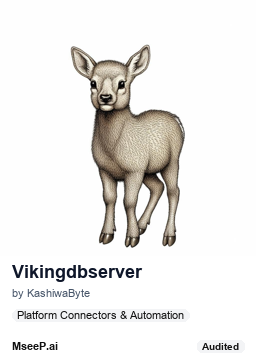README.md•4.27 kB
[](https://mseep.ai/app/kashiwabyte-vikingdb-mcp-server)
# VikingDB MCP server
[](https://archestra.ai/mcp-catalog/kashiwabyte__vikingdb-mcp-server)
[](https://smithery.ai/server/mcp-server-vikingdb)
an mcp server for vikingdb store and search
## What is VikingDB
VikingDB is a high-performance vector database developed by ByteDance.
You can easily use it following the doc bellow:
https://www.volcengine.com/docs/84313/1254444
### Tools
The server implements the following tools:
- vikingdb-colleciton-intro: introduce the collection of vikingdb
- vikingdb-index-intro: introduce the index of vikingdb
- vikingdb-upsert-information: upsert information to vikingdb for later use
- vikingdb-search-information: searche for information in the VikingDB
## Configuration
- vikingdb_host: The host to use for the VikingDB server.
- vikingdb_region: The region to use for the VikingDB server.
- vikingdb_ak: The Access Key to use for the VikingDB server.
- vikingdb_sk: The Secret Key to use for the VikingDB server.
- collection_name: The name of the collection to use.
- index_name: The name of the index to use.
## Quickstart
### Install
### Installing via Smithery
To install VikingDB MCP server for Claude Desktop automatically via [Smithery](https://smithery.ai/server/mcp-server-vikingdb):
```bash
npx -y @smithery/cli install mcp-server-vikingdb --client claude
```
#### Claude Desktop
On MacOS: `~/Library/Application\ Support/Claude/claude_desktop_config.json`
On Windows: `%APPDATA%/Claude/claude_desktop_config.json`
Development/Unpublished Servers Configuration
```
{
"mcpServers": {
"mcp-server-vikingdb": {
"command": "uv",
"args": [
"--directory",
"dir to mcp-server-vikingdb",
"run",
"mcp-server-vikingdb",
"--vikingdb-host",
"your host",
"--vikingdb-region",
"your region",
"--vikingdb-ak",
"your access key",
"--vikingdb-sk",
"your secret key",
"--collection-name",
"your collection name",
"--index-name",
"your index name"
]
}
}
}
```
Published Servers Configuration
```
{
"mcpServers": {
"mcp-server-vikingdb": {
"command": "uvx",
"args": [
"mcp-server-vikingdb",
"--vikingdb-host",
"your host",
"--vikingdb-region",
"your region",
"--vikingdb-ak",
"your access key",
"--vikingdb-sk",
"your secret key",
"--collection-name",
"your collection name",
"--index-name",
"your index name"
]
}
}
}
```
## Development
### Building and Publishing
To prepare the package for distribution:
1. Sync dependencies and update lockfile:
```bash
uv sync
```
2. Build package distributions:
```bash
uv build
```
This will create source and wheel distributions in the `dist/` directory.
3. Publish to PyPI:
```bash
uv publish
```
Note: You'll need to set PyPI credentials via environment variables or command flags:
- Token: `--token` or `UV_PUBLISH_TOKEN`
- Or username/password: `--username`/`UV_PUBLISH_USERNAME` and `--password`/`UV_PUBLISH_PASSWORD`
### Debugging
Since MCP servers run over stdio, debugging can be challenging. For the best debugging
experience, we strongly recommend using the [MCP Inspector](https://github.com/modelcontextprotocol/inspector).
You can launch the MCP Inspector via [`npm`](https://docs.npmjs.com/downloading-and-installing-node-js-and-npm) with this command:
```bash
npx @modelcontextprotocol/inspector uv --directory dir_to_mcp_server_vikingdb run mcp-server-vikingdb --vikingdb-host your_host --vikingdb-region your_region --vikingdb-ak your_access_key --vikingdb-sk your_secret_key --collection-name your_collection_name --index-name your_index_name
```
Upon launching, the Inspector will display a URL that you can access in your browser to begin debugging.